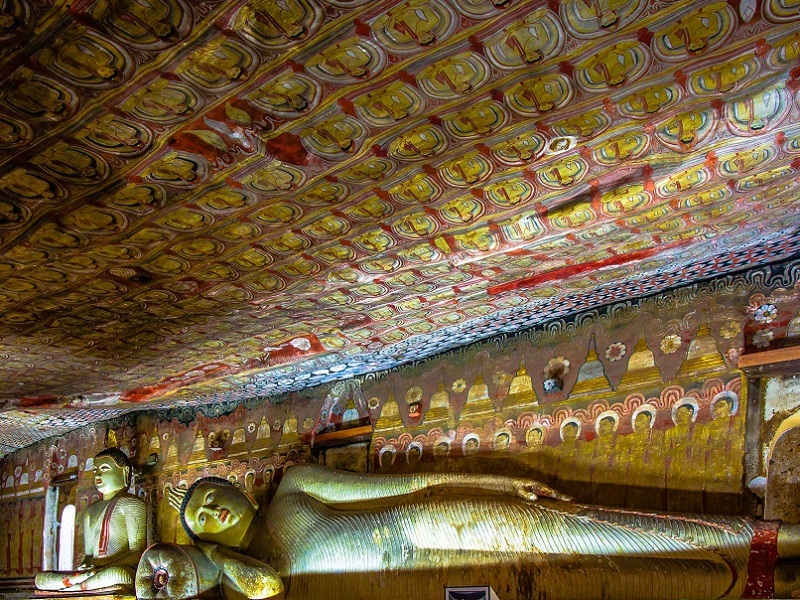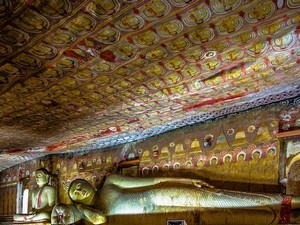Dambulla Cave Temple, Sigiriya - Timings, History, Architecture, Best Time to Visit
 #4 of 9 Places to Visit in Sigiriya
#4 of 9 Places to Visit in Sigiriya
 Distance (From Sigiriya): 17 Kms
Distance (From Sigiriya): 17 Kms
 Trip Duration (Including Travel): 2-3 Hours
Trip Duration (Including Travel): 2-3 Hours
 Place Location: At Dambulla
Place Location: At Dambulla
 Transportation Options: + Walk/Trek
Transportation Options: + Walk/Trek
 Travel Tips: Since this is a pilgrimage site, one should prefer wearing clothes that cover shoulders and knees, as a gesture of respect towards the culture. The cave temples are open till 7 PM, but most of the time, tickets get sold out till 5 PM. Hence it is advisable to get there either early in the morning, or by late afternoon.
Travel Tips: Since this is a pilgrimage site, one should prefer wearing clothes that cover shoulders and knees, as a gesture of respect towards the culture. The cave temples are open till 7 PM, but most of the time, tickets get sold out till 5 PM. Hence it is advisable to get there either early in the morning, or by late afternoon.
At a distance of 3 km from Dambulla Bus Station, 17 km from Sigiriya and 73 km from Kandy, Dambulla Cave Temples is an ancient cave temple complex situated at Dambulla in Sri Lanka. It is one of the popular places of pilgrimage in Sri Lanka and among the must-visit places for heritage lovers as part of Sri Lanka Packages.
Sitting on top of a 160-meter high rock, the Dambulla Cave Temple, also called as Golden Temple of Dambulla, has been a sacred pilgrimage site for 22 centuries and is one of the five UNESCO World Heritage Sites that the tiny island possesses. It is the best-preserved and most extensive cave temple complex of the country comprising of five main caves, each possessing numerous statues of Lord Buddha, some figures of kings and statues of Lord Vishnu along with Rock Paintings of vivid colours and shapes from around 2nd Century BC (Anuradhapura era) and continued up to the Kandyan era of the 18th Century. Dambulla is also a part of the 'Cultural Triangle' of Sri Lanka along with the town of Sigiriya and the city of Kandy.
The caves of Dambulla were occupied in very early times by Buddhist hermits. The Dambulla Rock Temple had first been constructed during the reign of King Vattagamini Abaya. During a South Indian invasion, the king sought refuge here for 15 years. After regaining the kingdom of Anuradhapura, to show his gratefulness for his safe place, he converted those caves into Buddhist Temples by constructing walled partitions under the rock overhang which spans the entire area as a single large cave. He got drip ledges made along this large cave and made it suitable to withstand rainy weather and avoided water seeping inside the caved areas. After King Vattagamini Abaya, King Vijayabahu I (1055-1110 AD) of Polonnaruwa and King Nissanka Malla (1187-1196 AD ) renovated these caves. During the 18th century, the caves were restored and painted by the rulers of the Kingdom of Kandy.
There are five caves inside, each with a different interior and statues. The first one is called 'Devaraja Lena Vihara' - Lord of the Gods' temple as it is believed that the god Sakka (King of Gods) gave the finishing touches to the principal image of this cave. The cave is known for its 45 feet long Sleeping Buddha Statue in parinirvana pose. The second cave is called 'Maharaja Lena Vihara' - Temple of the Great Kings. As the name suggests, this cave is dedicated to the kings Valagamba, and Nissanka Malla. Painted all over in brilliant colors, this is the largest and the most impressive one amongst the caves of Dambulla. This cave contains 53 images of Buddha in different attitudes.
The third cave, called 'Maha Alut Viharaya' (the Great New Temple) was constructed by the King Sri Rajasinha and is separated from Cave No.2 by a wall of masonry. This is said to have been used as a storeroom before the eighteenth century. There is a reclining Buddha statue of 30 feet in length carved out of the living rock. The principal image, facing the entrance, is a standing one under a torana which is surrounded by 50 smaller Buddha statues. A statue of King Sri Rajasinha is also found here by the right side of the entrance. The ceiling of the cave is adorned with a fascinating thousand seated Buddha paintings.
The fourth cave is called the Paschima Viharaya or the Western Temple which contains ten figures of Lord Buddha. The main attraction here is the beautiful seated Buddha in the dhyana mudra posture with a Makara Torana. There is a stupa called Soma Cetiya in the middle of the cave. The 5th cave known as Devana Alut Viharaya is the newest of all cave temples at Dambulla and the exact construction time of this temple is not in records. One can find 32 feet long reclined Buddha image along with standing and seated Buddha images totaling to eleven here.
Even before beginning the steep ascent for Dambulla Rock Temple, you will be awed by the sight of a huge golden Buddha statue that marks the entrance to the Dambulla Museum. This majestic sculpture is considered to be Asia's largest Buddha statue in the Dhyan Chakra mudra. One can take a quick walk through the museum, which is free of charge. There is also a small museum of wall art for those interested in Sri Lankan art.
There are three entrances to the temple complex, but only one ticket counter. If you enter through the Golden Temple or the local entrance halfway down the hill, you will have to walk downhill to the temple counter. There is no way to buy tickets at the top where they collect them. One needs to climb 360 steep steps in order to reach the cave complex from the bottom.
Timings: 7 AM - 7 PM
Entry: LKR. 1500 for Foreigners















